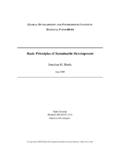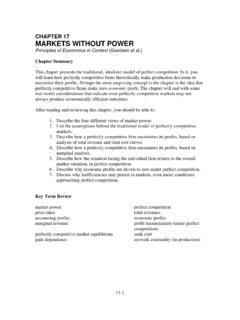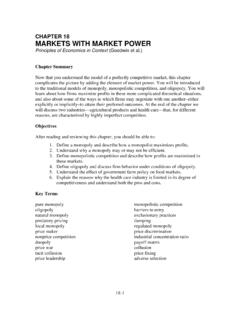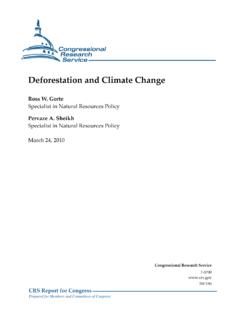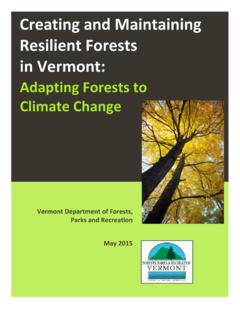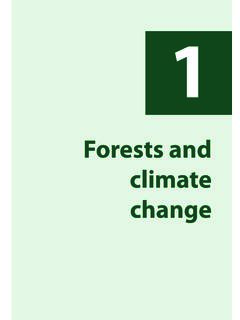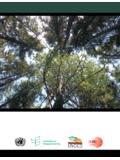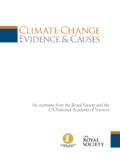Transcription of Forests, Agriculture, and - Tufts University
1 Forests, Agriculture, and climate : Economics and Policy IssuesGlobal Development And Environment InstituteTufts UniversityMedford, MA 02155 By Jonathan M. Harris and Maliheh Birjandi Feriz A GDAE Teaching Moduleon Social and Environmental Issues in Economics 1 Copyright 2011 Global Development And Environment Institute, Tufts University . Copyright release is hereby granted for instructors to copy this module for instructional purposes. Students may also download the module directly from Comments and feedback from course use are welcomed: Global Development And Environment Institute Tufts University Medford, MA 02155 E-mail: 2 CONTENTS 1.
2 THE ROLE OF FORESTS AND AGRICULTURE IN climate change .. 3 Importance of forests in the carbon cycle .. 5 Scale of world forest coverage and forest loss .. 9 What causes deforestation? .. 12 2. REDUCING EMISSIONS FROM DEFORESTATION AND DEGRADATION .. 15 The structure of REDD .. 15 Potential of REDD mechanisms for carbon reduction .. 16 3. THE ECONOMICS OF REDD .. 19 REDD Costs .. 19 Establishing a baseline .. 20 Permanence .. 21 Leakage .. 21 Estimating emissions from deforestation .. 23 4. AGRICULTURE AND climate change .. 24 The significance of agriculture .. 24 Potential for greenhouse gas mitigation in agriculture .. 26 The impact of biofuels.
3 27 Biofuels, food supply, and forests .. 32 5. CONCLUSION: NEW INSTITUTIONS FOR FORESTRY AND AGRICULTURE .. 33 REDD and development .. 34 KEY TERMS AND CONCEPTS .. 36 REFERENCES .. 38 DISCUSSION QUESTIONS .. 41 WEB LINKS .. 42 3 1. THE ROLE OF FORESTS AND AGRICULTURE IN climate change The problem of global climate change has occurred because the balance of the world s carbon cycle has been upset. Atmospheric carbon emissions by humans, together with other greenhouse gases such as methane, exceed the earth s capacity to store carbon in forests, oceans and living and dead biomass. The solution to the problem must lie in reducing human-created carbon emissions, increasing carbon absorption capacity, or both.
4 The focus of most climate policy discussions has been on reducing industrial emissions, and with good reason -- industrial emissions account for about 70% of total greenhouse gases (GHG s), and it is virtually impossible to imagine ways to absorb and store this much excess carbon. But it is also true that non-industrial areas including land use, forestry, and agriculture account for about 30% of emissions. Agriculture and forestry hold significant potential for storing excess carbon not enough to solve the problem, but certainly enough to be a significant contribution to any systematic policy solution.
5 For this reason, attention has started to focus on the issues of land use, forestry and agriculture sometimes referred to as REDD (reduction of emissions from deforestation and degradation) or, more broadly as LULUCF (Land Use, Land Use change , and Forestry). The world s forests store more than 650 billion tons of carbon: 44 percent in biomass, 11 percent in dead wood and litter, and 45 percent in soil. According to the Intergovernmental Panel on climate change (IPCC) 2007 report, deforestation accounts for about 17%-18% of global anthropogenic GHG emissions, the biggest contributor after energy supply (power and fossil fuel), which accounts for about 26 percent of emissions (IPCC 2007) (Figure 1).
6 Figure 1. Forestry and Agriculture as a Percent of Total Greenhouse Gas Emissions Source: Figure adapted from UN Framework Convention on climate change (UNFCCC 2007). Power Supply 21% Industry 19% Forestry 17% Agriculture 14% Transport 13% Building 8% Fossil fuel supply 5% Waste 3% Power Supply Industry Forestry Agriculture Transport Building Fossil fuel supply Waste 4 As shown in Figure 2, deforestation and timber harvest together contribute of GHG emissions, offset by 2% carbon absorption from afforestation (increase in forest area) and reforestation (regrowth in harvested areas) Most of the emissions from deforestation are in the form of CO2, while emissions from agriculture, primarily methane (CH4) and nitrous oxide (NO2)
7 , amount to of global GHG emissions. These figures indicate that reduction of emissions from deforestation and agriculture could be a significant part of global efforts to combat climate change and reduce GHG emissions. The possibility of mitigating climate change by reducing carbon emissions caused by deforestation and forest degradation, and by increasing carbon uptake through afforestation and sustainable forest management, has become a significant feature of global discussions on responses to climate change . Figure 2. Sources and Flows of Greenhouse Gases Figure source: World Resource Institute (WRI)1, accessed 2011.
8 1 Chart can be accessed at 5 Forests are increasingly being conserved and managed for multiple uses and values often in combination (Figure 3). Around 949 million hectares, or 24 percent of all forests, are designated for multiple uses, managed for a combination of the production of goods, protection of soil and water, conservation of biodiversity and provision of social services (see Box 1 on p. 7). Agricultural lands are primarily used for production of food and other agricultural products, but can also serve functions of soil and water protection and carbon storage, depending on agricultural techniques.
9 In this module, we will focus on the potential of forests and agricultural lands to help solve the problem of climate change , and examine some of the policy initiatives that have begun to take advantage of this potential. Figure 3. Designated functions of forests, 2010 Source: Global forest Resources Assessment, by Food and Agriculture Organization of the United Nations, 2010 (FAO 2010) Importance of forests in the carbon cycle Let s have a closer look at the linkages between forestry and climate change and clarify some related definitions in order to better understand the role of forests in combating climate change .
10 Forests can affect the global carbon cycle in two different ways: Forests as carbon stocks: a forest , like any other ecosystem, accumulates carbon from the atmosphere by breaking down carbon dioxide into carbon and oxygen. The carbon thus generated is stored in tree trunks, branches, leaves, and other parts of plants, as well as in soils as living and dead biomass. The dry biomass of a tree is about 2 tons, which can contain around 1 ton of carbon. A tropical wet forest can store up to 430 tons of carbon per hectare in aboveground biomass (CIFOR 2009). Production 29% Protection of soil and water 8% Conservation of biodiversity 12% Social services 4% Multiple use 24% Other 7% Unknown 16% Production Protection of soil and water Conservation of biodiversity Social services Multiple use Other Unknown 6 Forests as carbon fluxes: The second way through which forests can affect the carbon cycle is carbon fluxes they generate.


